THE APPLICATION OF THE AUTOSEGMENTAL PHONOLOGICAL THEORY TO THE INDONESIAN REDUPLICATION
on
LINGUISTIKA
THE APPLICATION OF THE AUTOSEGMENTAL PHONOLOGICAL THEORY TO
THE INDONESIAN REDUPLICATION
Ni Luh Ketut Mas Indrawati Universitas Udayana
Abstrak.
Artikel ini membahas reduplikasi yang dilihat dari teori fonologi Autosegmental yang diusulkan oleh John Goldsmith. Konsep dasar dari teori ini adalah bahwa representasi fonologis berbeda dengan representasi fonologis dalam teori generative dan traditional. Representasi fonologis dalam teori Autosegmental terdiri dari serangkaian segmen bersama dengan serangkaian elemen lain yang disebut autosegmen dan hubungan yang khusus diantara segmen-segmen tersebut, jika tidak akan menghasilkan bentuk yang tidak berterima. Prinsip dalam menghubungkan elemen fonemik dengan pola prosodik (elemen CV) diusulkan oleh Marantz seperti berikut: A. konsonan dihubungkan dengan slot konsonan sedangkan vokal dihubungkan dengan slot vokal, hubungan harus ketat satu lawan satu dan dimulai dari fonem melodi. Slot bisa dipre-asosiasikan (dihubungkan mendahului)dengan fonem tertentu. Pre-asosiasi mendahului asosiasi autosegmental yang mulai dari melodi fonemik. Arah asosiasi: bisa dari kiri ke kanan (untuk prefiks) atau dari kanan ke kiri (untuk sufiks) tapi asosiasi harus tetap menuju akar kata. Hasilnya menunjukkan bahwa reduplikasi dalam bahasa Indonesia melibatkan afiksasi. Yang diafikskan ke akar kata atau kata dasar bisa seluruh fonem melodi dari akar kata/kata dasar (seperti yang digambarkan pada reduplikasi penuh) atau sebagian fonem melodi seperti yang digambarkan dalam reduplikasi sebagian.
Abstract.
This article analysed reduplication which is viewed from the theory of Autosegmental phonology proposed by John Goldsmith. The basic concept of this theory is that a phonological representation is not the same as that in the generative traditional theory. This theory sees phonological representation as not symply a sequence of segments (each with its properties) but it consists of a string of other elements called autosegments and a specified mapping between them, otherwise it will yield illformed word. The principle in associating fonemic element to the prosodic templete (CV element) is imposed by Marantz
as follows: a. consonant links to C slot while vowel links to V slot, association is strictly one-to-one and it starts with melody phoneme. b. CV slot can be prelinked to specific phonemes and pre-association is prior to the autosegmental linking starting from phonemic melody. c. Directions of linking: either the leftmost melody phoneme links with the leftmost appropriate CV slot (for prefix) or the rightmost melody phoneme links with the rightmost appropriate CV slot (for suffix) and linking proceeds towards the root. The result shows that Indonesian reduplications involves affixation and what is affixed to the roots or stems can be the whole CV elements of the root or stem (as illustrated by full reduplications) . or part of the CV elements of the root or stem (as illustrated by partial reduplications)
Key word: Autosegmental, reduplication, and elements
Phonological theory has developed since 1970s. The most important development was the theory of Autosegmental Phonology proposed by John Goldsmith in his doctoral desertation in 1976. This theory was essentially a theory of tone languages in which the phonemic representation cannot be analysed based on linear agglutinative approach. The fundamental idea here is that phonological representation is more than just a sequence of segments with its properties, rather it consists of a string of segments together with a string of other elements called autosegments and a specified mapping between them.
The principles of this theory were applied by John Mc Carty in 1979 ( in spencer, 1990) to the problem of Semitic root-and-pattern morphology to produce a theory of nonconcatinative morphology. Marantz also used the idea to account reduplication in Agta. He proposes that reduplication is essentially affixation but that what is affixed is a CV (Consonant Vowel) skeleton or prosodic template, the phonemic content of the reduplicative affix is then obtained by copying the complete phoneme melody of the root and linking it to the affixal CV template respecting the principles of association in Autosegmental theory (in Spencer.1990, McCarty. 1992, Roca.1994)
Following Marantz’ model in describing reduplication, this article attempts to analyse the Indonesian reduplication.
The theory of autosegmental phonology views a phonological representation as not simply a sequence of segments (each with its properties) but it consists of a string of segments together with a string of other elements called autosegments and a specified mapping between them.
Goldsmith (1990) states that autosegmental representation differs from familiar generative and traditional phonemic representation in that it consists of two or more tiers of segments. Each tier itself consists of a string of segments but the segments on each tier differ with regard to what features are specified in them. A tone language is used as an example. Tones are represented on a separate tier, the tonal tier and on this tonal tier each segment is specified for tone only. The segments on the other, non tonal tier are specified for all other features.
Examples taken from Goldsmith (1990)
1a. Segmental
b u l u
b. (+syll) (-syll) (+syll)
Tonal
H L
(+high) (-high)
H(high),L(low),Syll(syllabic)
In 1a, the segments are not analysed as features, in 1b, features are used to illustrate much the same representation.
The principal of this theory was developed by John McCarty (1979) to produce a theory of non-concatinative morphology. In his theory a representation of a morpheme or word is segmented into more than one strings or tiers. That is a string of consonants and vowels which is called a prosodic template or CV tier or CV Skeleton and a string consisting of ordinary phonemic elements called melody elements. These melody elements should be linked to the CV slots in the prosodic template. The association should follow a simple set of principles governing the association of melody to CV slots, otherwise it will yield illformed word.
Marantz (1982) (in Roca,1994:12) analyses reduplication as involving the affixation of certain string of CV elements (specified to the language or the affixation process in question). The phonemic content of the reduplicative affix is the obtained by copying the complete
phonemic melody of the root and linking it to the affixal CV template. The principles of association of melody elements to prosodic template are imposed in analyzing reduplications, they are:
Condition A: Melody consonants link to C slots and melody vowel to V slots, association is strictly one to one and linking is melody driven (it starts with a melody phonemes and then tries to find an
I appropriate CV slot, not the other way around)
Condition B: slots can be pre-associated to specific phonemes. Pre-association is prior to the autosegmental linking from the root melody.
Condition C: Linking directions: either the left-most melody phoneme links with the left most appropriate CV slot and linking proceeds from right-to-left. In the unmarked case, linking proceeds towards the root. Ie: left-to-right for prefixes and right-to-left for suffixes.
Marantz’s procedure in analyzing Agta reduplication “taktakki” “legs (takki “leg”) can be illustrated in 2a-c.
2.
t a k k i
t a k k i
t a k k i |
+ C V C C V stem melody copy t a k k i + C V C C V association t a k k i + C V C C V clean up t a k k i |

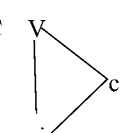
The analysis consists of three steps: they are: melody coppy in which the melody phonemes of the stem are copied , association ( in this step the melody phonemes associate to the CV slots, melody consonants link to C and melody vowel to V and linking starts from -left to-right and it proceeds towards the stem/root), and clean up (in this step the melody phonemes that cannot associate are erased). It can be seen that the reduplication in the above example involves prefixation. What is prefixed to the stem is the CV elements of the stem.
The Indonesian reduplications are classified into two. They are reduplications without affixations and reduplications with affixations.
-
A. Reduplication without affixations can be classified into four. They are:
-
1. Full Reduplications, ie: buku-buku, sekali-sekali, sepeda-sepeda, etc. This type of reduplications is very productive in Indonesian.
-
2. Partial Reduplications. In this type of reduplications, only parts of the root of the words are reduplicated, ie: lelaki, beberapa, tetamu, pertema-tama, etc.
-
3. Reduplications with vowel change. In this type of reduplications, one of the vowel of the word root are changed, ie: mondar-mandir, compang-camping, huru-hara, etc.
(these are not considered as reduplications by Ramlan (1987), since it is hard to ditermin the word root. But with the words bolak- balik , gerak-gerik, serba-serbi, the roots are balik,gerak,and serba.
-
4. Reduplications with consonants change, ie: lauk-pauk, ramah-tamah, sayur-mayur,etc
-
B. Reduplications with Affixations.
Reduplicatons with affixation can be devided into:
-
1. Full reduplications with suffix –an, ie: kereta-keretaan, rumah-rumahan, sayur-sayuran,etc.
-
2. Full reduplications with affix ke- -an, ie: kehitam-hitaman, keputih-putihan, kemerah-merahan,etc.
-
3. Full reduplications with affix se- -nya , ie: semahal-mahalnya, sejelek-jeleknya, seluas-luasnya, etc.
-
4. word formations partially reduplicated, ie: mengambil-ambil, berjalan-jalan, ditarik-tarik, terbatuk-batuk, berlari-larian, minum-minuman, kelima-lima,etc.
A1. /buku/ / buku-buku/
C V C V +
C
V
/b u k u +
b
u
k
C
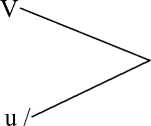
Root melody copy
C V C V
C
V
/b u k u +
C V C V
b
+
/b u k u
+
u
C
b
k
V
u
C

Association
C
k
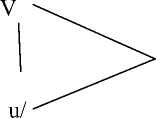
Clean up
The analisis above shows that condition A and C (A, Melody consonants link to C slots and melody vowel to V slots, association is strictly one to one and linking is melody driven, it starts with a melody
phoneme and then tries to find an appropriate CV slot, not the other way around. C. Linking direction: since the second /buku/ is treated as the stem/root, linking direction is from left-to-right , linking direction for prefixes) are applied. Therefore it can be said that in full reduplication the whole melody phonems of the root is affixed to the root.
A2. /laki/
/ ləlaki/
C
V
+
C
V
C
V
/ l
a
k
i
+
l
a
k
i/
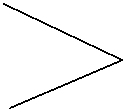
Root melody copy
C
l
C
/l
ə
V
+
C
V
C
V
a
ə
V
k
i
+
+
a k i
+
l
a
k
i
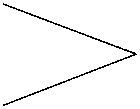
Association
C
V
C
V
l
a
k
i
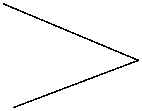
Clean up
Analysis A.2 shows the application of condition A,B and C (B. slots can be pre-associated to specific phonemes,in this case V slot is pre-associated to phoneme /ə/ and pre-association is prior to the autosegmental linking from the root melody.) The root of the word is /laki/ and the linking direction starts from left most consonant /l/ associated with C slot. This shows linking direction for prefixes. What is prefixed to the root in this case is only part of the CV melody elements of the root.
A.3. /balik/
/bolak-balik/
C V C V C + C V C V C
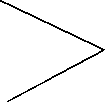
Root melody copy
o a
b a l i k
b a l
C V C
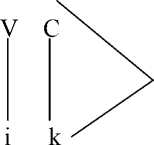
Association
o a
C V C V C +
/b I a l i k +
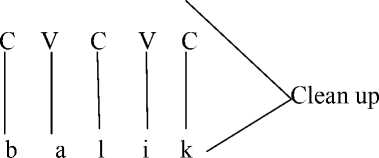
Analisis A3. Shows that condition A,B, and C are applied, the root of the word is /balik/. In the association the V slot is pre-associated to the phoneme /o/ and the other V slot is preassociated to the phoneme /a/ and pre-association is prior to the autosegmental linking. Then the left most melody consonant is associated with the C slot and linking proceeds towards the root. Since phoneme. Since /o/ and /a/ have been pre-linking to the V slots so /a/ and /i/ are left unassociated. They are erased in the clean- up step. Some of the melody phonemes are prefixed to the root in this type of reduplication.
C V V C
Root melody copy
P
Association
p
I
C V V C
Clean up
p a u k/
The above analysis shows that conditions A, B, and C are applied. The root of the word is /lauk/. In the association step, the C slot is pre-associated to consonant /p/ and this preassociation is prior to the autosegmental linking. Therefore /l/cannot associate to the C slot and it is erased in the clean up step. Linking proceeds towards the root and starts from right to left so some of the melody phonemes are suffixed to the root in this type of reduplication.
-
4.B. Reduplications with affixation
-
B.1 /rumah/ /rumah-rumahan/
-
C V C V C + V C
Root melody copy
r u m a h + a n/
C V C V C + V C
Association
Clean up
In the illustration above, /rumah/ is the root, since there is no/rumahan/ in Indonesian. Then the reduplication is suffixed with /-an/. The reduplication follows the condition A and C. The linking direction follows the linking direction for suffixes that is from right to left proceeding towards the root.
-
4.B.2. /hitam/ / kəhitam-hitaman/
k ə + h
i t a m +
C V C V C + C V
Root melody copy
h i t a m + a n
Association
Clean up
h i t a m + a n
Analysis 4.B.2. shows that the root is /hitam/ not /kehitam/ or /hitaman/ . The process of the reduplication is similar to full reduplication which involves conditions A and C , what is affixed to the root is the whole melody phonemes of the root. If the first /hitam/ is treated as the root so the melody phonemes are suffixed to it and if the second one the melody phonemes are prefixed to the root. /ke- an/ are affixed after the reduplication process.
-
4.B.3. /mahal/ —► /s a mahal-mahalna/
CV + C V C V C +
C V C V C + C V
s ə + m a h a l +
m a h a l + n a

Root melody copy
CV + C V C V C +
C V
C
s ə + m a h a l +
CV + C V C V C +
m a
h
a l
V C
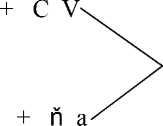
Association
s ə + m a h a l +
C V C V C + C V
Clean up
m a h a l + n a
Analysis 4.B.3. shows that the root is /mahal/ not /semahal/ or /mahalan/ . The process of the reduplication is similar to full reduplication which involve conditions A and C , what is affixed to the root is the whole melody phonemes of the root. If the first /mahal/ is treated as the root so the melody phonemes are suffixed to it and if the second one, the melody phonemes are prefixed to the root. /se- nya/ are simultaneously affixed after the reduplication process.
-
4.B.4. /minuman/ /minum-minuman/
C V C V
/m i n u
C V C V
/m i n u
C V C V
/m i n u
C V C V C V C
Root melody copy m i n u m a n
C V C V C V C
Association
m i n u m a n
C V C V C C V
Clean up
m i n u m a n
The illustration above shows that /minuman/ is the stem not /minum/ since reduplication in Indonesian does not change word class (/minum/ “to drink” is a verb and /minuman/ “ drink”is a noun. Conditions A and C are applied with linking direction from left to right, linking direction for prefixes. It can be seen in the clean up step that /a,n/ cannot associate so they are erased. Therefore, what is prefixed to the stem here is only some of the melody phonemes of the stem.
5. Conclusions
From the analysis above it can be concluded that Indonesian reduplications involves affixations. What is affixed to the root can be the whole melody phonemes of the root or stem( as illustrated in full reduplications) or part of the melody phonemes as illustrated in partial reduplications.
All types of reduplications follow linking conditions A(melody consonants link to C slots and melody vowels to V slots, association is strictly one to one and linking is melody driven) and C(linking directions: the left most melody phoneme links with the left most appropriate CVslot or the right most melody phoneme links with the righ most appropriate CV slot. And linking proceeds towards the root/stem). Only reduplications with vowel or consonant changes apply prelink condition or condition B, and prelink is prior to the autosegmental links.
BIBLIOGRAPHY
Goldsmith, John A. 1990. Autosegmental and Metrical Phonology. Basil, Blackwel.Ltd. UK
Mc Carthy and Andrew Carstain, 1992. Current Morphology. Routledge.London.
Ramlan, M.1987. Morfologi; Suatu Tinjauan Deskriptif. C.V.Karyono. Yogyakarta.
Rocca, Iggy.1994. Generative Phonology. Routledge. London.
Spencer Andrew. 1991. Morphological Theory. Basil Blackwell Ltd. UK.
Vol. 15, No. 29, September 2008
SK Akreditasi Nomor: 007/BAN PT/Ak-V/S2/VIII/2006
244
Discussion and feedback